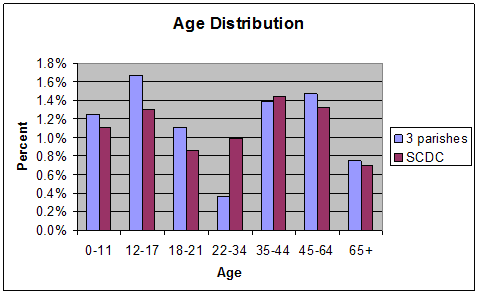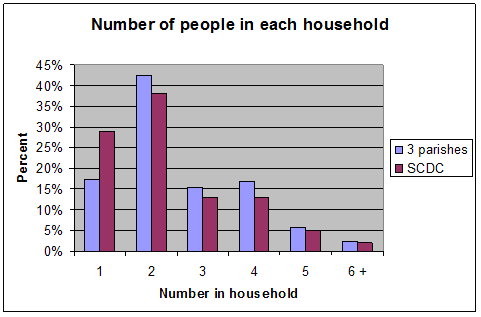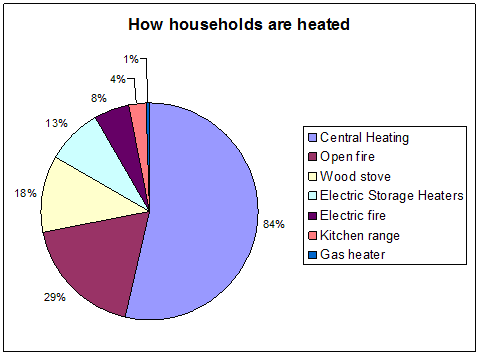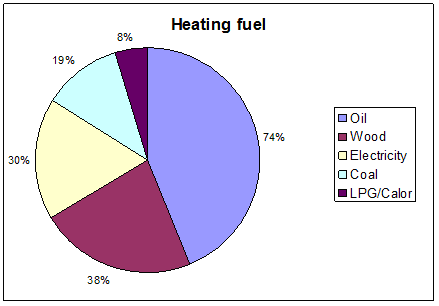9.1 Household Survey
273 completed household surveys were returned from a total of 397 households - a 69% return rate.
We first asked the number of people in the household in specific age ranges. The results are below.
|
Age Range |
Number in range |
Percent in range |
|
0-11 |
61 |
15.1% |
|
12-17 |
51 |
10.0% |
|
18-21 |
26 |
4.4% |
|
22-34 |
31 |
4.7% |
|
35-44 |
65 |
13.9% |
|
45-64 |
136 |
29.4% |
|
65+ |
103 |
22.5% |
Initially it would appear that all ages below 45 are under-represented in the villages. However, a closer inspection shows that some of the age ranges are quite wide (e.g. 45-64 has 20 years between the lower and upper limits) and others are narrow (18-21 has only 4 years). The bar chart below takes the percentage in each age range and divides by the number of years in each range. This gives a better view of the age profile. It also compares this with data for Suffolk Coastal District Council taken from the 2001 census (this can be found on the UK Government census website).

As we can see, this shows that the most under-represented age range is 22 to 34. We assume that the reason for this is that either younger people can't afford to set up home in the villages, so leave for other locations or that they don't return after going to University or distant work places. As they become older and more affluent, they can afford to move in and hence the higher proportion of above-35s.
We can also see the number of people in each household in the graph below.

Comparing the survey data with the 2001 census data for SCDC , we find that the parishes have significantly fewer single person households and slightly more multi-occupancy households.
We also asked what type of housing people lived in - mortgaged/owned, rented, etc. and whether the house was detached, semi-detached, etc. We found that 86% was either mortgaged or owned outright, 7% was rented privately, 3% was rented from a housing association and 2% was occupied as a part of employment.
Detached properties comprised 66% of the housing, with 21% semi-detached. 26% are bungalows. According to a survey by Halifax in 2005 , bungalows make up only 2% of UK housing stock, so we are clearly well served by single storey living accommodation.
Householders were asked how they heated their homes in winter and a summary is in the pie chart below (the percentages add up to more than 100%, since many people use more than one method):

The fuel used is shown in the pie chart below (this also adds to greater than 100%, since many households use more than one fuel):

It's clear that oil is the major heating source for the houses in the villages and this, together with comments from householders, leads to an action arising from the survey.
Action 1 Investigate scope for co-operative oil purchase aiming to reduce oil price and the number of vehicle journeys.
Householders were then asked which mains services they receive. Well in excess of 90% receive mains water, telephone and electricity. Only 37% receive mains sewerage and no-one has mains gas. Of those who do not receive mains sewerage, 40% said they would like to. 46% of respondents said they would like to receive mains gas. Suffolk ACRE has told us that Suffolk Coastal District Council hold a list of Parishes wanting mains drainage.
Action 2 Parish Councils to inform SCDC of residents' desire for development of mains services.
Householders were asked about their computing facilities. 85% told us they own a computer and 77% said that they have broadband internet access. This compares with the UK figures of 65% who owned a computer in 2006 and 56% who have broadband internet access .
Questions about vehicle ownership showed that, on average, village households have 1.8 cars and 1.4 bicycles. Just over half the households have 2 cars, but 5% of households have 6 or more bikes! Comparable car ownership figures from the 2001 census showed 1.3 cars per household in the SCDC area and 1.1 cars per household in England as a whole.
The next set of questions covered home insulation. This shows that, of those who knew, 69% of households were of cavity wall construction. Of those, 74% had cavity wall insulation installed and 26% did not. 60% said that their house had less than 9" of loft insulation, which is below the current government recommendation of 270 mm (10.6") .
Action 3 Liaise with SCDC to improve household insulation and encourage householders to take advantage of grants, etc.
Finally, residents were asked if they would help with a number of community activities. 49% were willing to offer help to mobility-impaired villagers to get prescriptions, 31% would help with shopping and 29% were willing to help collect litter from the roadside. 20 people were also interested in joining a "Walking Bus" scheme to get children to school. The names of those interested/willing to help are on file so that they can be asked if appropriate.